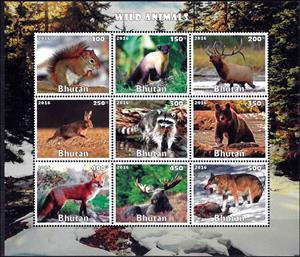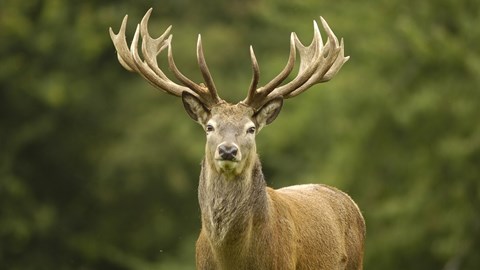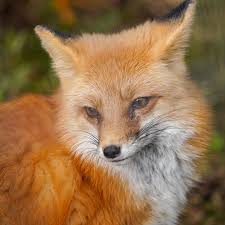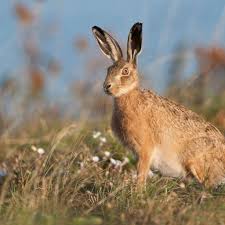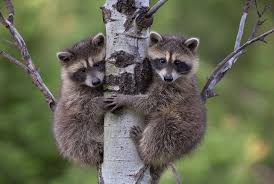Mini Sheet: Wild Animals (Cinderellas 2016)
Wild Animals (Cinderellas 2016)
01 January (Cinderellas ) within release Bhutan goes into circulation Mini Sheet Wild Animals face value 2,700 Bhutanese ngultrum
| Mini Sheet Wild Animals in catalogues | |
|---|---|
| Colnect codes: | Col: BT 2016-05 |
Mini Sheet is square format.
Also in the issue Bhutan:
- Mini Sheet - Calibri face value 2,700;
- Stamp - Owl face value 350;
- Stamp - Calibri face value 150;
- Stamp - Owl face value 250;
- Stamp - Calibri face value 500;
- Mini Sheet - Owls face value 2,700;
- Stamp - Owl face value 150;
- Stamp - Owl face value 300;
- Stamp - Calibri face value 350;
- Stamp - Owl face value 450;
- Stamp - Owl face value 150;
- Stamp - Calibri face value 300;
- Stamp - Owl face value 250;
- Stamp - Owl face value 200;
- Stamp - Owl face value 500;
- Stamp - Calibri face value 450;
- Stamp - Calibri face value 100;
- Stamp - Owl face value 100;
- Stamp - Owl face value 300;
- Stamp - Calibri face value 200;
- Stamp - Owl face value 200;
- Stamp - Owl face value 350;
- Mini Sheet - Owls face value 2,700;
- Stamp - Calibri face value 400;
- Stamp - Owl face value 450;
- Stamp - Owl face value 400;
- Stamp - Calibri face value 250;
- Stamp - Owl face value 500;
- Stamp - Owl face value 100;
- Stamp - Owl face value 400;
- Stamp - Wild Animals face value 400;
- Mini Sheet - Turtles face value 2,700;
- Stamp - Lizard face value 500;
- Stamp - Lizard face value 300;
- Stamp - Primates face value 200;
- Stamp - African Animals face value 500;
- Stamp - Dog face value 100;
- Stamp - Dog face value 500;
- Stamp - Wild Animals face value 300;
- Stamp - African Animals face value 250;
- Mini Sheet - Wild Animals face value 2,700;
- Stamp - Wild Animals face value 500;
- Stamp - Primates face value 150;
- Stamp - African Animals face value 200;
- Stamp - Turtle face value 250;
- Stamp - Turtle face value 450;
- Stamp - Lizard face value 150;
- Stamp - Primates face value 100;
- Stamp - Wild Animals face value 350;
- Stamp - Primates face value 450;
- Stamp - Dog face value 150;
- Stamp - Lizard face value 450;
- Stamp - African Animals face value 400;
- Stamp - African Animals face value 150;
- Stamp - Turtle face value 100;
- Stamp - Dog face value 350;
- Stamp - African Animals face value 300;
- Stamp - Dog face value 400;
- Stamp - Wild Animals face value 450;
- Stamp - Turtle face value 300;
- Mini Sheet - Lizards face value 2,700;
- Stamp - African Animals face value 450;
- Stamp - Lizard face value 350;
- Stamp - Primates face value 300;
- Stamp - Wild Animals face value 250;
- Stamp - Dog face value 450;
- Stamp - Lizard face value 200;
- Stamp - Dog face value 200;
- Stamp - Dog face value 250;
- Stamp - Primates face value 500;
- Stamp - Turtle face value 200;
- Stamp - Turtle face value 500;
- Stamp - Wild Animals face value 200;
- Stamp - African Animals face value 100;
- Stamp - Lizard face value 400;
- Stamp - Dog face value 300;
- Stamp - African Animals face value 350;
- Stamp - Lizard face value 250;
- Stamp - Turtle face value 150;
- Stamp - Turtle face value 350;
- Mini Sheet - Dogs face value 2,700;
- Mini Sheet - African Animals face value 2,700;
- Stamp - Lizard face value 100;
- Stamp - Primates face value 350;
- Mini Sheet - Primates face value 2,700;
- Stamp - Wild Animals face value 100;
- Stamp - Turtle face value 400;
- Stamp - Primates face value 400;
- Stamp - Wild Animals face value 150;
- Stamp - Primates face value 250;
- Mini Sheet - Snakes face value 2,700;
- Stamp - Snakes face value 100;
- Stamp - Snakes face value 150;
- Stamp - Snakes face value 200;
- Stamp - Snakes face value 250;
- Stamp - Snakes face value 300;
- Stamp - Snakes face value 350;
- Stamp - Snakes face value 400;
- Stamp - Snakes face value 450;
- Stamp - Snakes face value 500;
Mini Sheet Wild Animals it reflects the thematic directions:
Animals are multicellular, eukaryotic organisms of the kingdom Animalia (also called Metazoa). All animals are motile, meaning they can move spontaneously and independently, at some point in their lives. Their body plan eventually becomes fixed as they develop, although some undergo a process of metamorphosis later on in their lives. All animals are heterotrophs: they must ingest other organisms or their products for sustenance.
A deer (pl.: deer) or true deer is a hoofed ruminant ungulate of the family Cervidae. It is divided into subfamilies Cervinae (which includes, among others, muntjac, elk (wapiti), red deer, and fallow deer) and Capreolinae (which includes, among others reindeer (caribou), white-tailed deer, roe deer, and moose). Male deer of almost all species (except the water deer), as well as female reindeer, grow and shed new antlers each year. These antlers are bony extensions of the skull and are often used for combat between males.
Foxes are small-to-medium-sized omnivorous mammals belonging to several genera of the family Canidae. They have a flattened skull; upright, triangular ears; a pointed, slightly upturned snout; and a long, bushy tail ("brush").
Hares and jackrabbits are mammals belonging to the genus Lepus. They are herbivores, and live solitarily or in pairs. They nest in slight depressions called forms, and their young are able to fend for themselves shortly after birth. The genus includes the largest lagomorphs. Most are fast runners with long, powerful hind legs, and large ears to dissipate body heat. Hare species are native to Africa, Eurasia and North America. A hare less than one year old is called a "leveret". A group of hares is called a "husk", a "down", or a "drove".
Mammals are any vertebrates within the class Mammalia (/məˈmeɪli.ə/ from Latin mamma "breast"), a clade of endothermic amniotes distinguished from reptiles (including birds) by the possession of a neocortex (a region of the brain), hair, three middle ear bones and mammary glands. All female mammals nurse their young with milk, secreted from the mammary glands. Mammals include the largest animals on the planet, the great whales. The basic body type is a terrestrial quadruped, but some mammals are adapted for life at sea, in the air, in trees, underground or on two legs. The largest group of mammals, the placentals, have a placenta, which enables the feeding of the fetus during gestation. Mammals range in size from the 30–40 mm (1.2–1.6 in) bumblebee bat to the 30-meter (98 ft) blue whale. With the exception of the five species of monotreme (egg-laying mammals), all modern mammals give birth to live young. Most mammals, including the six most species-rich orders, belong to the placental group. The largest orders are the rodents, bats and Soricomorpha (shrews and allies). The next three biggest orders, depending on the biological classification scheme used, are the Primates (apes and monkeys), the Cetartiodactyla (whales and even-toed ungulates), and the Carnivora (cats, dogs, seals, and allies).
The raccoon , also spelled racoon and sometimes called the common raccoon or northern raccoon to distinguish it from the other species, is a mammal native to North America. It is the largest of the procyonid family, having a body length of 40 to 70 cm (16 to 28 in), and a body weight of 5 to 26 kg (11 to 57 lb). Its grayish coat mostly consists of dense underfur, which insulates it against cold weather. The animal's most distinctive features include its extremely dexterous front paws, its facial mask, and its ringed tail, which are common themes in the mythologies of the Indigenous peoples of the Americas surrounding the species. The raccoon is noted for its intelligence, and studies show that it is able to remember the solution to tasks for at least three years. It is usually nocturnal and omnivorous, eating about 40% invertebrates, 33% plants, and 27% vertebrates.
Squirrels are members of the family Sciuridae a family that includes small or medium-sized rodents. The squirrel family includes tree squirrels, ground squirrels (including chipmunks and prairie dogs, among others), and flying squirrels. Squirrels are indigenous to the Americas, Eurasia, and Africa, and were introduced by humans to Australia. The earliest known fossilized squirrels date from the Eocene epoch, and among other living rodent families, the squirrels are most closely related to the mountain beaver and dormice
